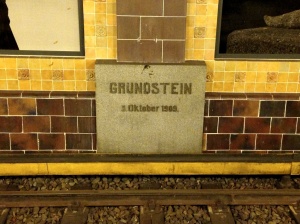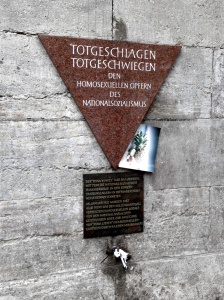From Podbielskiallee, I decided to walk to the next station. I strolled through more of Berlin’s pleasant suburbia, along a wide boulevard.
The U-Bahn tracks, above ground until this point, dive back underground. They weren’t far beneath my feet though, as I was reminded occasionally when I heard the roar of a passing train through the vents in the central reservation of Schorlemerallee. Berlin is built on a swamp, which precluded the use of deep tunnels for the most part, so the tunnels are “cut and cover” type, with the trains running just below street level.
A few minutes later and I was at Breitenbachplatz. Take your choice of entrances: the original staircase, or a more recently added building with lift access. I went with the former for the selfie pic.
The real prize, though, is underground. The platforms are ornately decorated with friezes on the walls, carefully designed patterns around the lights in the ceilings and – yes! – massive columns spread along the island platform.
This is the sort of underground station that the ancient Romans would have built.
It’s a similar story at the next station, Rüdesheimer Platz, although the design is different. In fact, each station along this stretch of line seems to have its own individual style; a nice touch which gives a different feel, almost a “personality”, to each station.
The station has been given a modern twist by graffiti art on the walls here. Berlin, in common with many European cities, does have a problem with graffiti artists whose tags never seem to get cleaned off walls. Unlike the graffiti I saw almost everywhere else, this seemed to be officially sanctioned.
At one of the station entrances, the original ticket offices were, of course, boarded up. However, care had been taken to retain the railings and other period features, including lamps like the one shown above.
A quick sign photo, and back onto the train.
The next stop was Heidelberger Platz and… Oh, my.
Less underground station, more cathedral. It immediately brought to mind the Moscow Metro, but it in fact predates the similarly grand stations there by a good few years. Wikipedia tells me that this is a “groin vault”, which does not amuse me in the slightest.
A grand station like this would never be built today, of course. However, I can’t help but like the idea that a station can be a notable and interesting place in itself, rather than just a place you get into and out of as soon as possible on the way to somewhere better.
It was the little touches that pleased me. I didn’t notice them straight away (and I probably missed some completely) but there are features such as animals carved into the stonework (like the owl shown above. Then there’s the ornate entrance gates. The decorations on the walls. The tiled ticket hall. The carved crest at the entrance to the platforms. I could go on and on.
I must have spent a good 20 minutes marvelling at the station.
I eventually dragged myself away and boarded another train for the short ride to Fehrbelliner Platz.
Now we return to the style of the previous stations, again with its own individual tile work and design.
Above ground, things are different. The entrance to Fehrbelliner Platz was rebuilt in 1970, when an interchange was added with the U7. A new entrance building was built, and it frankly doesn’t get any more 1970s than this:-
The station is surrounded by Nazi-era Government buildings – the red and green provides a welcome dash of colour amidst the stark grey concrete. There’s also some sort of statue or artwork on the central reservation of the road outside the station. I wasn’t able to find out too much information online, but I suspect I wasn’t putting the right keywords into Google.
I walked the short distance to Hohenzollernplatz. A woman was talking on her Handy at the station entrance, so I felt very self-conscious getting the sign pic. I had to wait until she turned her back on me.
It was only when I looked at the pictures hours later that I realised I had a giant stone eagle perched on my head. Oh well.
Walking down to the station platform, I saw that there was something of an eagle theme to the station: they were carved into the tilework too.
This was another attractive station, retaining its period features while at the same time, a modern lift for disabled access had been tastefully inserted.
While waiting for my next train, I spied the foundation stone (Grundstein) for the entire line halfway along the tracks. The station opened four years after construction began, on 12th October 1913.
I had put Spichernstraße on my itinerary with a note: “skip if running short of time”. I was running a bit behind schedule, but realistically I was not going to miss it out and leave a gap on the map.
Spichernstraße is a later addition to the line, opening in 1959, and thus has none of the grandeur of the previous stations. It was a generic underground station, with harsh fluorescent lighting. Perfectly functional, of course, but after the earlier stations, it was a bit disappointing.
While I was waiting for the train, I noticed two men standing near me on the platform. One was wearing a kilt and knee-high boots, the other was dressed head to toe in tight leather. Folsom Europe, “the biggest gay fetish event in Europe”, was being held in Berlin’s gay district this weekend. I’m guessing the pair were attendees. This being Berlin, nobody else in the station batted an eyelid.
Augsburger Straße (opened 1961) is similarly plain – in fact, I’m pretty sure the design brief for the station simply read: “make it like Spichernstraße, but with orange tiles”.
Its most notable feature, from my point of view, is the sign at the entrance which seemed positioned to make my selfie-taking as challenging as possible. I had to keep moving up and down the steps to find the best angle, much to the chagrin of people who were actually trying to use the station.
Time to move swiftly on, I think.
I was getting closer to the end of the line now. Was my little station-collecting excursion going to end with an anti-climax?
Not a bit of it. I walked to Wittenbergplatz where I was greeted by this imposing station building:
Wittenbergplatz’s grand exterior reflects its status as one of the key stations on the network. The square from which the station takes its name lies at the intersection of several major shopping streets, and the giant Kaufhaus des Westens department store is nearby.
All this means the station is very busy. I was jostled by crowds inside as I tried to take pictures, but I hope the impressive nature of the station interior comes across. Bits of the station concourse have been given over to snack bars and fast food places, although there is also a staffed BVG information desk – a rarity on the network.
Here at platform level things are not as architecturally grand as some of the previous stations. However there are five platforms in all, with trains coming and going constantly, giving the station a really frenetic feel. And then there’s this:
The roundel was presented to Berlin by London Transport in 1953, to commemorate the 50th anniversary of the U-Bahn, and as a sign of post-war reconciliation. It’s amazing to think that two countries which were dropping bombs on each other a few years earlier could share this gesture of friendship (the Soviet occupation forces a few streets away probably helped focus minds).
There was just one final journey to make. My U3 train departed Wittenbergplatz parallel to a U2 train on the adjacent tracks. We raced each other for a short distance until the tracks diverged and the other train disappeared from view. My carriage juddered and shook as we clattered over some pointwork, before running into Nollendorfplatz.
This is one of the most important hubs on the network, with no fewer than four lines intersecting here. It’s also the terminus of the U3 line.
I ventured upstairs, where I avoided the cluster of people drinking at the entrance and wandered around to the other side of the station building to take the photo.
Nollendorfplatz is the nearest station to Berlin’s main gay district, and a small memorial on the station building commemorates the gay victims of Nazi persecution.
The U3 station is underground, but the U2 line emerges from its tunnel just west of the station and climbs onto an elevated track. The U2 station is therefore above ground, with a glass dome (a replica of the original which was destroyed during the way).
So that was it. I had completed my survey of the U3 from start to finish. I did it with perfect timing, too – my phone battery died just after taking the Nollendorfplatz sign picture. I had to head back to my hotel to recharge both myself and the phone.
Maybe my opinion would be different if I had to use it every day, but I loved Berlin’s U-Bahn – its trains and its stations. The system is not just a great way to get around the city, but an attraction in its own right.













































Lovely! You make me want to revisit Berlin sooner rather than later.
TYPO: with a glass dome (a replica of the original which was destroyed during the way).
During the war, I suspect.
I enjoyed your article. We have just returned from 6 days in Berlin and spent lots of time riding on their transport system. we found you blog very informative – thank you!
N&G – Bristol